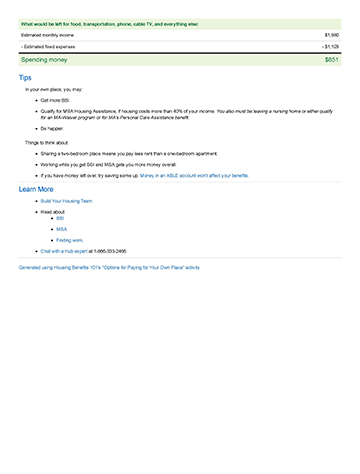My Vault
:
Activity
Options for Paying for Your Own Place


Do this Vault activity to Compare budget options for getting your own place.
View example
.Go To Activity
One of the keys to living in your own place is making sure you have enough money to pay for it.
If your parents or other people have always taken care of your expenses, it might seem especially hard to figure out how to pay for rent, food, and other expenses. But there are ways that you might be able to pay for your rent and other living expenses.
You will need to think about this and make a plan before you actually find a new place to live. That’s because you have to know what you can afford and how you will pay for it before you make a move.
Programs and jobs can help
If you are a young person with a disability and you’ve never lived in your own place before, you might not know how much money you’ll need to live in your own place or how you’ll come up with that money.
But there’s a way for you to get ideas: HB101’s Options for Paying for Your Own Place activity is designed for people with disabilities who have always lived at home or in another type of group setting. It can help you learn about different benefits that might help you pay your rent, such as Supplemental Security Income (SSI), Minnesota Supplemental Aid (MSA), and MSA Housing Assistance and shows how getting a job would give you more money to spend on the things you need and like.
It also suggests an estimated rent level based on average rent levels in Minnesota, so that you don’t have to know exactly how much rent will cost. And it lets you see how getting a roommate might make your rent cheaper.
In addition to Options for Paying for Your Own Place, HB101 has a guide to MN DHS Housing Programs that Help People with Disabilities that tells you where to learn more about some of the programs that can help you move into the community and get the services you need.
Living with another person
As the Options for Paying for Your Own Place activity may show you, sharing a house, an apartment, or townhome with other people can be one of the best ways to make living in your own place possible.
But it isn’t always easy to live with other people! You need to make sure that you really want to live with another person and that you can find somebody who you are comfortable living with.
My Vault
:
Planning Path
Live with Someone

A Vault path with a series of short activities to help you figure out if living in the community will be easier with another person.
Watch tutorial
.Go To Path
HB101’s Live with Someone path is a set of interactive activities that can help you think about what matters to you when you live with other people.
It can help you think about important issues when you are sharing an apartment, including things like:
- How many people you want to live with
- If you need support services to live as independently as possible in the place you choose
- If you want to have a live-in caregiver
- If you have pets or are okay if other people have pets, and
- How to solve problems with your roommates.
If you already are living with somebody or know who you plan to live with, you can use this path to make a formal agreement with the other person. This agreement can help you avoid arguments and problems later. The agreement can cover all sorts of things, like how much rent each person pays and even who cleans the kitchen or takes out the trash. Give it a try!
For more info about living with other people, check out HB101’s Living with Other People article.
And if you get MA-Waiver benefits and need a live-in caregiver, see if you can get extra Caregiver Living Expenses paid for that might help make your rent lower.




Give Feedback